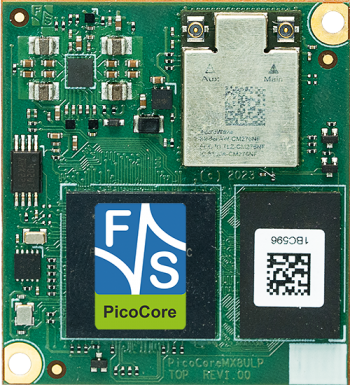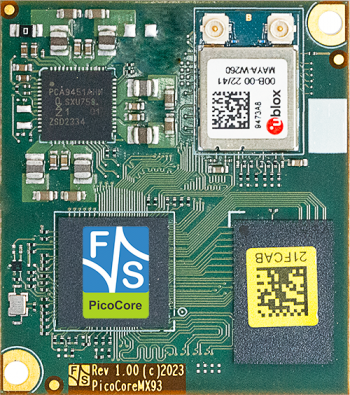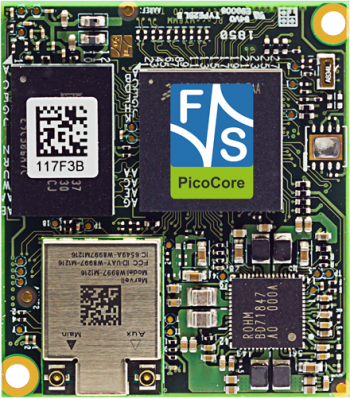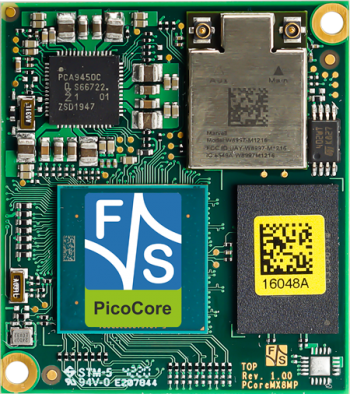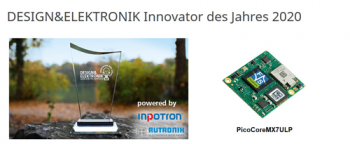PicoCore™
Computer on Module Produktfamilie
| PicoCore™MX6UL100 | PicoCore™MX8MN | PicoCore™MX8MM | PicoCore™MX8MP | PicoCore™MX91 | PicoCore™MX93 | PicoCore™MX8ULP | |
| Status | Production | Production | Production | Production | Samples | Samples | Samples |
| CPU | - | - | - | - | - | - | - |
| Typ | NXP i.MX 6ULL | NXP i.MX 8M Nano | NXP i.MX 8M Mini | NXP i.MX 8M Plus | NXP i.MX 91 | NXP i.MX 93 | NXP i.MX 8ULP |
| Kern | ARM Cortex-A7 | ARM Cortex-A53 Cortex-M7 |
ARM Cortex-A53 Cortex-M4 |
ARM Cortex-A53 Cortex-M7 HIFI-4 DSP, NPU |
ARM Cortex-A55 | ARM Cortex-A55 Cortex-M33 NPU |
ARM Cortex-A35 Cortex-M33 Hifi 4 DSP |
| Anzahl der Kerne | 1 | 1, 2, 4 + M7 | 4x A53 + 1x M4 | 2, 4 + M7 | 1x A55 | 2x A55 + M33 + NPU | 2x A35 + 1x M33 + DSP |
| Frequenz | max. 900MHz | max. 1.5GHz + 650MHz | max. 1.8GHz + 400MHz | max. 1.8GHz + 800MHz | 1.4GHz | 1.7GHz + 250MHz | 800MHz + 216MHz + 600MHz |
| L2-Cache | 128KB | 512KB | 512KB | 512KB | 256kB L2 | 2x64kB L2 + 256kB L3 | 512kB |
| GPU | - | 2D/3D GC7000 UltraLite (2 shader) | 2D GC328, 3D GCNanoUltra (1 shader) | 3D/2D, ES 3.1/3.0, CL™ 1.2 VG™ 1.1 | - | PXP | 2D, 3D: ES™ 3.1, CL™, VG™ 1.1 |
| VPU | - | - | 1080p60 HEVC H.265, VP9, H.264, VP8 | 1080p60, h.265/4, VP9, VP8, Video Encode: 1080p60, h.265/4 |
- | - | - |
| Betriebssystem | - | - | - | - | - | - | - |
| Linux | Buildroot/ Yocto (uboot installed) |
Buildroot/ Yocto (uboot installed) |
Buildroot/ Yocto (uboot installed) |
Yocto (uboot installed) |
Yocto (uboot installed) |
Yocto (uboot installed) |
Yocto (uboot installed) |
| Windows | - | - | - | 10 IoT Enterprise (UEFI installed) |
- | 11 IoT Enterprise (UEFI installed) |
- |
| Echtzeit | - | FreeRTOS | FreeRTOS | FreeRTOS | - | FreeRTOS | FreeRTOS |
| Speicher | - | - | - | - | - | - | - |
| Flash | max. 512MB SLC NAND EEPROM |
max. 512MB SLC NAND EEPROM |
max. 512MB SLC NAND EEPROM |
EEPROM | EEPROM | EEPROM | 2 kbit EEPROM |
| eMMC | max. 32GB | max. 64GB | max. 64GB | max. 64GB | max. 64GB | max. 64GB | max. 64GB |
| RAM | 512MB DDR3L | max. 2GB LPDDR4 x16 | max. 4GB LPDDR4/ DDR3L | max. 8GB LPDDR4 x32 | max. 2GB LPDDR4 x16 |
max. 2GB LPDDR4 x16 |
max. 2GB LPDDR4 x32 |
| Schnittstellen | - | - | - | - | - | - | - |
| SD-Karte | 1x SDIO | 2x extern | 2x extern | max. 2x extern | 2x SDIO | max. 2x SDIO | max. 2x SDIO |
| Ethernet | max. 2x 100 Mb opt. RMII |
max. 2x 100/1000Mb opt. RGMII |
max. 2x 100/1000Mb opt. RGMII |
max. 2x 100/1000Mb opt. RGMII |
max. 2x 100/1000Mb opt. 1x RGMII |
max. 2x 100/1000Mb opt. RGMII |
1x 100Mb opt. RMII |
| WLAN | 802.11 ac/a/b/g/n (2.4/ 5GHz) |
802.11ac/a/b/g/n | 802.11 ac/a/b/g/n (2.4/ 5GHz) |
802.11 ac/a/b/g/n (2.4/ 5GHz) |
WIFI6 | WIFI6 | 802.11 ac/a/b/g/n (2.4/ 5GHz) |
| BT | 5.3 | 5.3 | 5.3 | 5.3 | 5.2 | 5.2 | 5.3 |
| USB Host | 1x 2.0 | - | 1x | 1x 3.0 | 1x 2.0 | 1x 2.0 | 1x 2.0 |
| USB Device | 1x OTG 2.0 | 1x OTG 2.0 | 1x OTG 2.0 | 1x OTG 3.0 | 1x OTG 2.0 | 1x OTG 2.0 | 1x OTG 2.0 |
| CAN | 2x FlexCAN | 1x | 1x CAN-FD | max. 2x | max. 2x CAN-FD | max. 2x CAN-FD | 1x FlexCAN |
| UART | max. 4x | max. 4x | max. 4x | max. 4x | max. 8x | max. 8x | max. 4x |
| I2C | max. 4x | max. 4x | max. 4x | max. 4x | max. 4x | max. 4x | max. 4x |
| SPI | max. 2x | max. 2x | max. 2x | max. 2x | max. 2x | max. 2x | max. 2x |
| Audio | Line In/ Out/ Mic/ Headphone opt. I2S |
Line In/ Out/ Mic/ Headphone opt. I2S |
Line In/ Out/ Mic/ Headphone opt. I2S |
Line In/ Out/ Mic/ Headphone opt. I2S |
Line In/ Out/ Mic/ Headphone opt. I2S |
Line In/ Out/ Mic/ Headphone opt. I2S |
Line In/ Out/ Mic/ Headphone opt. I2S |
| ADC | - | - | - | - | 4x | 4x | 2x (12 Bit) |
| Touch Panel | via I2C or USB | via I2C or USB | via I2C or USB | via I2C or USB | via I2C or USB | via I2C or USB | via I2C or USB |
| Kamera | - | MIPI CSI | MIPI CSI | max. 2x MIPI-CSI | - | MIPI-CSI (2 lanes) |
MIPI-CSI (2 lanes) |
| PCIe | - | 1x | 1x | 1x | - | - | - |
| RTC | PCF85263ATL | extern | PCF85263ATL | PCF85263ATL | PCF85263ATL | PCF85263ATL | PCF85263ATL |
| sonstige Schnittstellen | max. 4x PWM, SPDIF, ESAI, SAI, SSI |
max. 4x PWM, SPDIF, ESAI, SAI, SSI | max. 4x PWM, Watchdog, SPDIF, ESAI, SAI, SSI |
max. 4x PWM, SPDIF, ESAI, SAI, SSI | max. 4x PWM, SPDIF, ESAI, SAI, SSI, TAMPER | max. 4x PWM, SPDIF, ESAI, SAI, SSI | PWM, Watchdog SPDIF/DMIC |
| Display | - | - | - | - | - | - | - |
| RGB | 18 Bit | - | - | - | 18 Bit | 18 Bit | 24 Bit |
| LVDS | 1x 4 Lanes | 2x 4 Lanes | 1x 4 Lanes | 2x 4 Lanes or 1x 8 Lanes |
- | 1x 4 Lanes | 1x 4 Lanes |
| CRT/DVI | - | - | - | -/1x | - | - | - |
| MIPI-DSI | - | 1x 4 Lanes | 1x 4 Lanes | 1x 4 Lanes | - | 1x 4 Lanes | 1x 4 Lanes |
| Allgemein | - | - | - | - | - | - | - |
| Stromversorgung | +3.8V bis 5.5VDC | +3.8V bis 5.5VDC | +3.8V bis 5.5VDC | +3.8V bis 5.5VDC | +3.8V bis 5.5VDC | +3.8V bis 5.5VDC | +3.8V bis 5.5VDC |
| Leistungsaufnahme | 2W typ. | 2W typ. | 3W typ. | 3W typ. | 3W typ. | 3W typ. | 1W typ. |
| Betriebstemperaturbereich | 0°C - +70°C -20°C - +85°C -40°C - +85°C |
0°C - +70°C -20°C - +85°C |
0°C - +70°C -20°C - +85°C |
0°C - +70°C -25°C - +85°C -40°C - +85°C |
0°C - +70°C -25°C - +85°C -40°C - +85°C |
0°C - +70°C -25°C - +85°C -40°C - +85°C |
0°C - +70°C -25°C - +85°C -40°C - +85°C |
| Größe | 35x40mm | 35x40mm | 35x40mm | 35x40mm | 35x40mm | 35x40mm | 35x40mm |
| Gewicht | ~10g | ~10g | ~10g | ~10g | ~10g | ~10g | ~10g |
| Minimale Verfügbarkeit | 2035 | 2034 | 2034 | 2036 | 2040 | 2038 | 2038 |
| PicoCore™MX6UL100 | PicoCore™MX8MN | PicoCore™MX8MM | PicoCore™MX8MP | PicoCore™MX91 | PicoCore™MX93 | PicoCore™MX8ULP |
Der kompakte Computer on Module Formfaktor PicoCore™ zeichnet sich durch seine geringe Größe von nur 35 x 40 mm und einem sehr geringen Board-to-Board Abstand ab 1,5mm aus.
PicoCore™ System on Modules eignen sich ideal für kleine und stromsparende Prozessoren von NXP, wie i.MX 8M Mini/ Nano oder i.MX 8M Plus.
Die PicoCore™ embedded Module zeichnen sich durch Robustheit, geringe Verlustleistung und hohe Performance aus und sind bestens geeignet für tragbare Geräte in der Medizin- und Industrietechnik, Multimediaanwendungen oder auch für sichere Cloudverbindungen.
Auf dem ARM-basierten PicoCore™ Formfaktor stehen bis zu 4 Cortex®-A53 Kerne und ein Cortex®-M4/M7 Kern zur Verfügung. Eine 1080p Hardware Videobeschleunigung zur Umsetzung von Zwei-Weg Videoapplikationen und eine integrierte 3D und 2D Hardwarebeschleunigung sind im Prozessor enthalten.
Als Speicher werden SLC NAND Flash und alternativ auch eMMC angeboten. Die zwei 100-poligen Steckverbinder ermöglichen eine Vielzahl an Schnittstellen wie 2x SD-Card Slot, 1-2 Gigabit Ethernet, 2x USB, CAN, 4x I2C, 2x SPI, 4x UART, Audio (Line In/ Out/ Mic/ Headphone oder I2S), PCIe, GPIO, PWM und MIPI-CSI für Kameraanbindung. Als Displayanschluss ist eine MIPI-DSI oder alternativ oft auch LVDS 24 Bit Schnittstelle vorgesehen, bei der auf NXP i.MX 8M Plus basierenden PicoCore™MX8MP zusätzlich noch DVI.
Zum Anschluss eines Touchpanels wird I2C verwendet. Optional steht bei einigen Versionen auch ein WLAN/ BT Modul zur Verfügung.
Wir unterstützen Sie optimal bei Ihrer Softwareentwicklung. Für jedes PicoCore™ Modul stehen umfangreiche, sofort lauffähige Development Kits mit Display zur Verfügung.
Die F&S Ingenieure leisten Support via Forum, Telefon und E-Mail. Des Weiteren bieten wir umfangreiche Leistungen in den Bereichen Over-The-Air Update, Secure Boot, Asymmetrisches Multiprocessing und vielem mehr.

